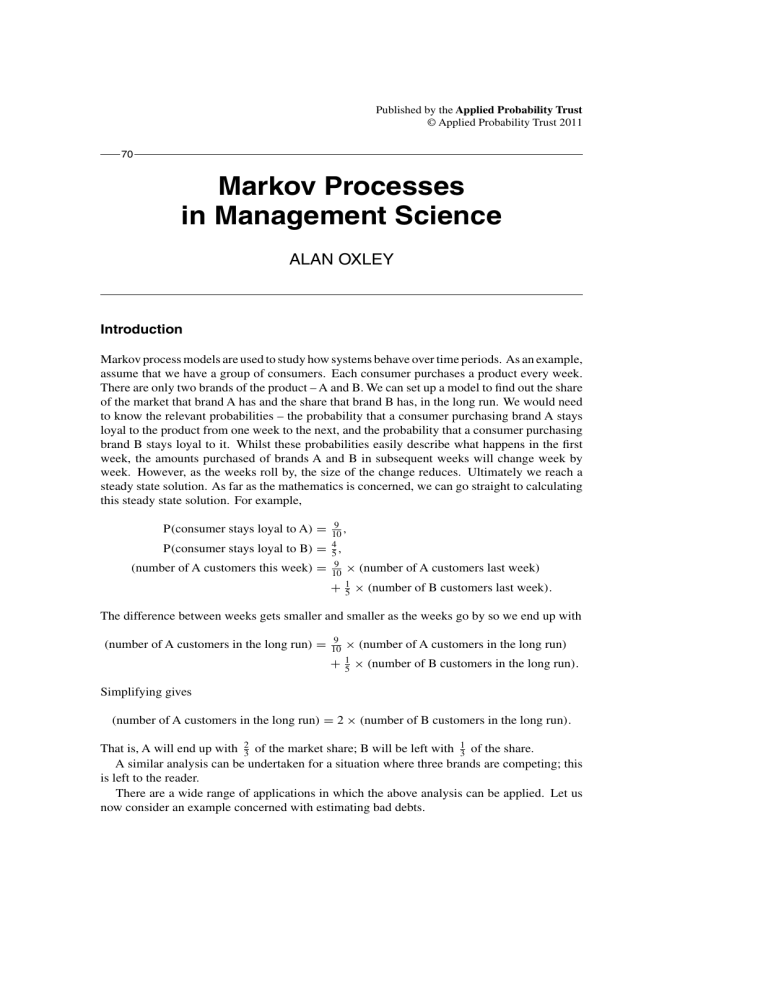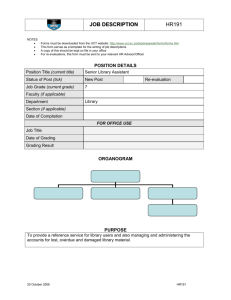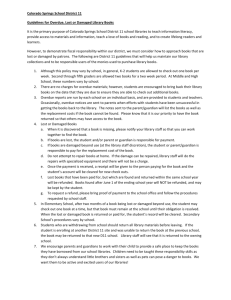Markov Processes in Management Science

70
Published by the Applied Probability Trust
© Applied Probability Trust 2011
Markov Processes in Management Science
ALAN OXLEY
Introduction
Markov process models are used to study how systems behave over time periods. As an example, assume that we have a group of consumers. Each consumer purchases a product every week.
There are only two brands of the product – A and B. We can set up a model to find out the share of the market that brand A has and the share that brand B has, in the long run. We would need to know the relevant probabilities – the probability that a consumer purchasing brand A stays loyal to the product from one week to the next, and the probability that a consumer purchasing brand B stays loyal to it. Whilst these probabilities easily describe what happens in the first week, the amounts purchased of brands A and B in subsequent weeks will change week by week. However, as the weeks roll by, the size of the change reduces. Ultimately we reach a steady state solution. As far as the mathematics is concerned, we can go straight to calculating this steady state solution. For example,
P
( consumer stays loyal to A
) =
P
( consumer stays loyal to B
) =
( number of A customers this week
) =
9
10
,
4
5
,
9
10
× ( number of A customers last week
)
+ 1
5
× ( number of B customers last week
).
The difference between weeks gets smaller and smaller as the weeks go by so we end up with
( number of A customers in the long run ) = 9
10
+
× ( number of A customers in the long run )
1
5
× ( number of B customers in the long run ).
Simplifying gives
( number of A customers in the long run
) =
2
× ( number of B customers in the long run
).
That is, A will end up with
2
3 of the market share; B will be left with
1
3 of the share.
A similar analysis can be undertaken for a situation where three brands are competing; this is left to the reader.
There are a wide range of applications in which the above analysis can be applied. Let us now consider an example concerned with estimating bad debts.
71
Estimating bad debts
Any company needs to keep track of the money that it is owed from its customers as well as from other companies. We could classify individual amounts as follows:
≤
30 days overdue,
31–90 days overdue,
91 or more days overdue.
The company must wonder whether it will ever receive those amounts in the latter category.
They are so long overdue we could call them ‘bad debts’.
From time to time a company must estimate what it will lose in the way of bad debts over a period of time in the future. In time, some of the amounts currently between 31 and 90 days old will become bad debts. When more time elapses, similarly, some of those in the first category will become bad debts.
Problem Given the amount owed today in the ‘
≤
30 days overdue’ category and the amount owed in the ‘31–90 days overdue’ category, how much of this will end up as bad debt?
Solution We can look at the historical records of the company to work out what proportion of the total amount ever to have been in the ‘
≤
30 days overdue’ category eventually ended up as a bad debt. Similarly, we can work out what proportion of the total amount ever to have been in the ‘31–90 days overdue’ category eventually ended up as a bad debt.
Example We have
P
(
‘
≤
30 days overdue’ amount ends up as bad debt
) = 1
7
,
P
(
‘31–90 days overdue’ amount ends up as bad debt
) = 1
3
, actual amount, today, in ‘
≤
30 days overdue’ category
=
£1 000
, actual amount, today, in ‘31–90 days overdue’ category
=
£2 000
.
How much of this £3 000 do we predict will end up as bad debt? The answer is
1 000
× 1
7
+
2 000
× 1
3
=
£809
.
52
.
Can the company’s management use a strategy to reduce the level of bad debt? Yes they could. For example, they could give a discount for prompt payment in the hope that it would increase the likelihood that amounts in the ‘
≤
30 days overdue’ category would be paid.
Problem How can we estimate the reduction in debt due to this policy?
Solution 1 – Guess how the overall probabilities change
Here we want to guess new values for
P
(
‘
≤
30 days overdue’ amount ends up as bad debt
),
P
(
‘31–90 days overdue’ amount ends up as bad debt
).
The problem with this is that it is difficult to get a feel for these probabilities.
72
3
10
4
10
3
10 paid
≤ 30 days overdue
− overdue bad debt
2
10
4
10
4
10
Figure 1
Solution 2 – Guess how the constituent probabilities change
In order to understand this solution, we must get an idea of what these constituent probabilities are and how the overall probabilities are derived from them.
At any point in time an account is in one of the following four states: paid, ≤ 30 days overdue, 31–90 days overdue, or bad debt. We can look again at the historical records of the company, this time in more detail. We need to work out the probability that an account in one state will have moved to another state, or stayed in the same state, in, say, 1 week’s time.
Let us consider an example. We will use a state diagram to show the probabilities of transferring from one state to another (see figure 1).
Alternatively, we can tabulate this information; see table 1.
Let us now try to find the probabilities in the long run. We will use a similar analysis to that which we used in solving the market share problem given earlier, i.e.
( amount in ‘paid’ this week
) = ( amount in ‘paid’ last week
)
+
+
4
10
4
10
× ( amount in ‘
≤
30 days overdue’ last week
)
× ( amount in ‘31–90 days overdue’ last week
).
Ignoring new accounts, we end up with the following degenerate solution:
( amount in ‘paid’ in the long run ) = ( amount in ‘paid’ in the long run ) + 0 + 0 .
We therefore have to use another approach.
current period paid
≤
30 days overdue
31–90 days overdue bad debt
Table 1 next period
≤
30 days 31–90 days paid overdue overdue
1
4
10
4
10
0
0
0
0
3
10
0
3
10
4
10
0 bad debt
0
0
2
10
1
73
N current state
≤
30 days overdue
31–90 days overdue
Table 2 next state
≤
30 days overdue 31–90 days overdue
10
7
0
5
3
5
7
We need to calculate the proportion of an account currently in the ‘
≤
30 days overdue’ category that will eventually end up as bad debt, and the proportion of an account currently in the ‘31–90 days overdue’ category that will eventually end up as bad debt. This requires the use of matrix algebra.
Let
Q be a matrix showing the probabilities for the ‘
≤
30 days overdue’ and ’31–90 days overdue’ states only, i.e.
Q =
3
10
0
3
10
4
10
.
We then evaluate
N = ( I − Q ) −
1
, which is referred to as the fundamental matrix ,
N = ( I − Q ) −
1
=
=
=
10
7
0
7
10
0
1 0
0 1
−
3
5
3
10
−
−
1
3
10
0
5
3
5
7 .
3
10
4
10
−
1
The n ij entry gives the average time the process is in state j given that it began in state i
.
Consider table 2. The
10
7 entry is the average number of weeks that a debt spends in the state
‘ ≤ 30 days overdue’ given that it started in the state ‘ ≤ 30 days overdue’. The
5
7 entry is the average number of weeks that a debt spends in the state ‘31–90 days overdue’ given that it started in the state ‘ ≤ 30 days overdue’, and so on.
We now need to use
R =
4
10
4
10
0
2
10
, where
R has the transition probabilities shown in table 3. Now,
NR =
10
7
0
7
5
3
5 4
10
4
10
0
2
10
=
6
7
2
3
1
7
1
3
.
74 currently in the state
‘
≤
30 days overdue’ currently in the state
‘31–90 days overdue’
Table 3 in 1 week is in the state ‘paid’ in 1 week is in the state ‘bad debt’
4
10
4
10
0
2
10
Looking at the second column we have:
P
(
‘
≤
30 days overdue’ amount ends up as bad debt
) =
P
(
‘31–90 days overdue’ amount ends up as bad debt
) =
1
7
,
1
3
.
These are the same figures we arrived at when we initially looked at the historical records, before we started to consider different states. If we use a discount policy to reduce the level of debt then we need to guess how the constituent probabilities change.
Adopting a new policy
Let us now return to the original problem. Management’s task is to attempt to reduce one or both of the following probabilities:
P
(
‘
≤
30 days overdue’ amount ends up as bad debt
),
P
(
‘31–90 days overdue’ amount ends up as bad debt
).
They have proceeded by looking at historical records and producing the state diagram (see figure 1). They are considering offering a discount for prompt payment. They must estimate the new probabilities for the transitions between states. Let us assume that the company believes that offering some sort of early payment incentive will change the original state diagram to the one in figure 2. Here, two of the probabilities have changed. The proportion of accounts that are settled within 30 days has risen to overdue’ category has fallen to
1
10
.
6
10 whilst the proportion moving into the ‘31–90 days
3
10
6
10
1
10 paid
≤ 30 days overdue
− overdue bad debt
2
10
4
10
4
10
Figure 2
75
Next the company perform the matrix calculations, as described above. This will give them new overall probabilities from which they can calculate an estimate of the total amount that is likely to become bad debt as follows:
Q =
3
10
0
1
10
4
10
, N =
10
7
0
10
42
10
6
, R =
6
10
4
10
0
2
10
, N R =
20
21
2
3
This gives
P
(
‘
≤
30 days overdue’ amount ends up as bad debt
) =
P
(
‘31–90 days overdue’ amount ends up as bad debt
) =
1
21
,
1
3
.
In the original problem we had £3 000 owing to the company. The new estimate for the amount that will end up as bad debt is
1 000 × 1
21
+ 2 000 × 1
3
= £714 .
29 .
The company can compare the two bad debt amounts – one without the early settlement policy in place and one with it in place. There is a £95
.
23 difference. Finally, the company can decide whether the savings justify the usage of the policy, bearing in mind that some of the
£95
.
23 will have to be spent on incentives.
There are a large number of texts that describe Markov processes. An example in the
Management Science application area is given by reference 1.
Reference
1 D. R. Anderson, D. Sweeney, T. A. Williams and K. Martin, An Introduction to Management Science ,
12th edn. (Thomson South-Western, Mason, OH, 2007).
Alan Oxley is a member of the Computer and Information Sciences
Department at the Universiti Teknologi PETRONAS, Malaysia. His research interests are wide-ranging – the teaching and learning of mathematics and IT, the use of IT in higher education, and emerging issues in IT. Outside mathematics and IT, he is especially interested in physical fitness.
1
21
1
3
.






